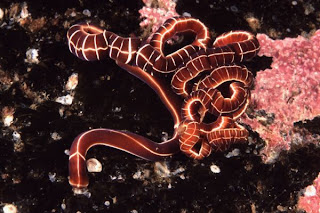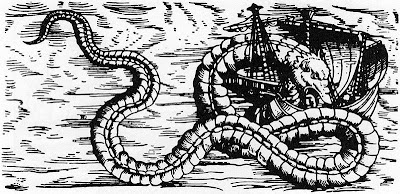Sea Orm
I have decided to choose the Sea Orm because it incorporates many different types of creatures and can appear to look either snake like or worm like. The Sea Orm is from Norwegian mythology and first described by Olaus Magnus in 1555 as a giant sea monster that terrorizes sailors and livestock. Magnus quotes the story of this monster: 'Those who sail up along the coast of Norway to trade or to fish, all tell the remarkable story of how a serpent of fearsome size, 200 feet long and 20 feet wide, resides in rifts and caves outside Bergen. On bright summer nights this serpent leaves the caves to eat calves, lambs and pigs, or it fares out to the sea and feeds on sea nettles, crabs and similar marine animals. It has ell-long hair hanging from its neck, sharp black scales and flaming red eyes. It attacks vessels, grabs and swallows people, as it lifts itself up like a column from the water.' (Magnus, 1555)
The Sea Orm
I believe this sea monster is a mix between sea worms and fish. Magnus mentions the creature has ell-long (about 18 inches) hair hanging from its neck. One limbless animal matches that description which is a polychaete worm, to which it has bristle like appendages that run along from its head to its tail, some even have longer sensory organs on their heads. These bristles aid in movement and in some worms are a form of respiratory system.
Polychaete Worms
Some species of sea worms can also grow quite large, one that was discovered in a public aquarium measured 4 foot long, a polychaete worm that was destroying coral reef and killing fish. Other sea worms such as ribbon worms can grow to over 100 foot long, but are quite slim only measuring a couple of millimeters in length. Sea worms have a monstrous and creepy appearance with grotesque bodies and viscous jaws.
4ft Polychaete worm
Ribbon Worms
Another aquatic animal which also fits the description of having ell-long hair is an oarfish. This fish has a dorsal fin that begins on its head with a few high spines and runs the entire length of its body. This is also a giant fish reaching lengths of 56 foot. It has an unusual swimming pattern which not only consists of the normal locomotion of many fish, but it also swims in a completely vertical manner. Similar to the description of lifting itself up like a column of water, but instead of actually rising out of the water it is seen below its surface.
Oarfish
Many cartilaginous fish have sharp scales such as sharks and rays. One fish, the sturgeon has quite prominent sharp scales running along its body, which could add to the description of being a monster with sharp scales.
Sturgeon
Another semi-aquatic creature called a caecilian has a worm like body and creepy appearance. Being an amphibian means it spends its time in damp conditions in the soil, leaf litter and in the water.
Caecilian










+ribbon+worm+(orange).jpg)






















